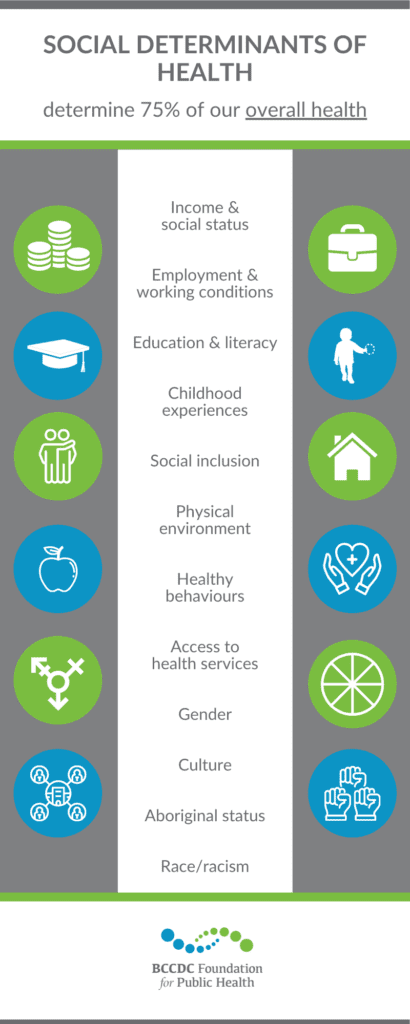We toss around a lot of acronyms in the public health world. Here’s one you may have seen before–SDOH. It’s an acronym with a lot of weight, and one we need to put more emphasis on in order to address health inequities and create a truly healthy society.
So what does it stand for and why is it so important?
The Social Determinants of Health, or SDOH are a group of social, economic and environmental factors that impact one’s place in the world, and one’s health status. They include:
- Income and social status
- Employment and working conditions
- Education and literacy
- Childhood experiences
- Physical environments
- Social supports and coping skills, social inclusion
- Healthy behaviours
- Access to health services
- Biology and genetic endowment
- Gender
- Culture
- Race/racism
- Aboriginal status

These factors connect a person to the societal structures surrounding them. They influence all aspects of that person’s life, where they live, work, and play. They can have positive or negative effects; for example people with higher income tend to enjoy more well-being. It may not seem entirely clear how things like social supports and inclusion, or race, gender, and culture, have anything to do with health. But about 75% of our overall health is determined by social factors like these. When people are disadvantaged from achieving health due to social determinants, inequitable situations are created.
For example, stigma, discrimination based on race or gender identity, and historical trauma are deep influencers that impact where one may live, what income level one may have, whether one has had opportunities to go to school, or learn a sport. All these factors impact health–from accessing health care, to not being able to afford healthy food, to exposure to unsafe situations at work, to having to survive winter temperatures living on the street. The list goes on.
Here’s a story to illustrate:
Imagine a teenaged girl who lives with a single mom who has chronic health conditions. Her mom has a hard time maintaining full-time work, so they’re reliant on social supports such as income assistance and the food bank. She is racialized and lives in a low-income neighhourhood that can be unsafe at night. The built environment lacks healthy food options, green space, or safe communal spaces. In order to help her mom, she finds a job. She works in a retail store downtown but has to commute by bus, sometimes late at night. This costs her money, time, and energy and she can’t also maintain the workload at high school, so she leaves.
She experiences violence from a male friend of her mom’s and feels unsafe at home. So she goes to stay on a friend’s couch. Because of her changes in her environment and the emotional trauma that comes from the assault, she loses her job. Eventually, after couch surfing for a while, she finds herself living on the street. She can’t find work because she doesn’t have a high school diploma or an address, she has no family to support her, and she faces discrimination and stigma every day. All of this impacts how she experiences her community and her social environment, and limits her chance to achieve good health. Her physical, emotional, mental and spiritual health are obstructed by factors out of her control.
Now imagine how her life could be different if we addressed things like racism and gender inequality, put an emphasis on equity and creating good health, focused our efforts across sectors to create positive supports and environments, and didn’t let people slip through the cracks.
This scenario is an example of how inter-connected social factors can influence and impact someone throughout their life. This story is not uncommon. It represents health disparities and inequities. It does not reflect fault, wrongdoing, or poor choices. It demonstrates a set of factors working against the basic human rights of this young girl; a set of uncontrollable factors that drive her path and leave her vulnerable.
We have to think about the social factors working around us every day, shaping who we all are as humans, and either creating our opportunities for life and health, or throwing up barriers that inhibit our ability to access the fundamental things we need to survive and thrive. This story represents an example that may seem extreme to some. But it’s not. Even in a socially aware, wealthy and democratic country, we need to accept that many of our peers have stories like this.
In public health, we must work together with other sectors to create health equity and address the SDOH, or we will never create a truly healthy society made up of healthy humans. We must shift our thinking about health beyond the healthcare system. We have much work to do. We must change this narrative.
You can play a role. Join us as we #ActivateHealth.
